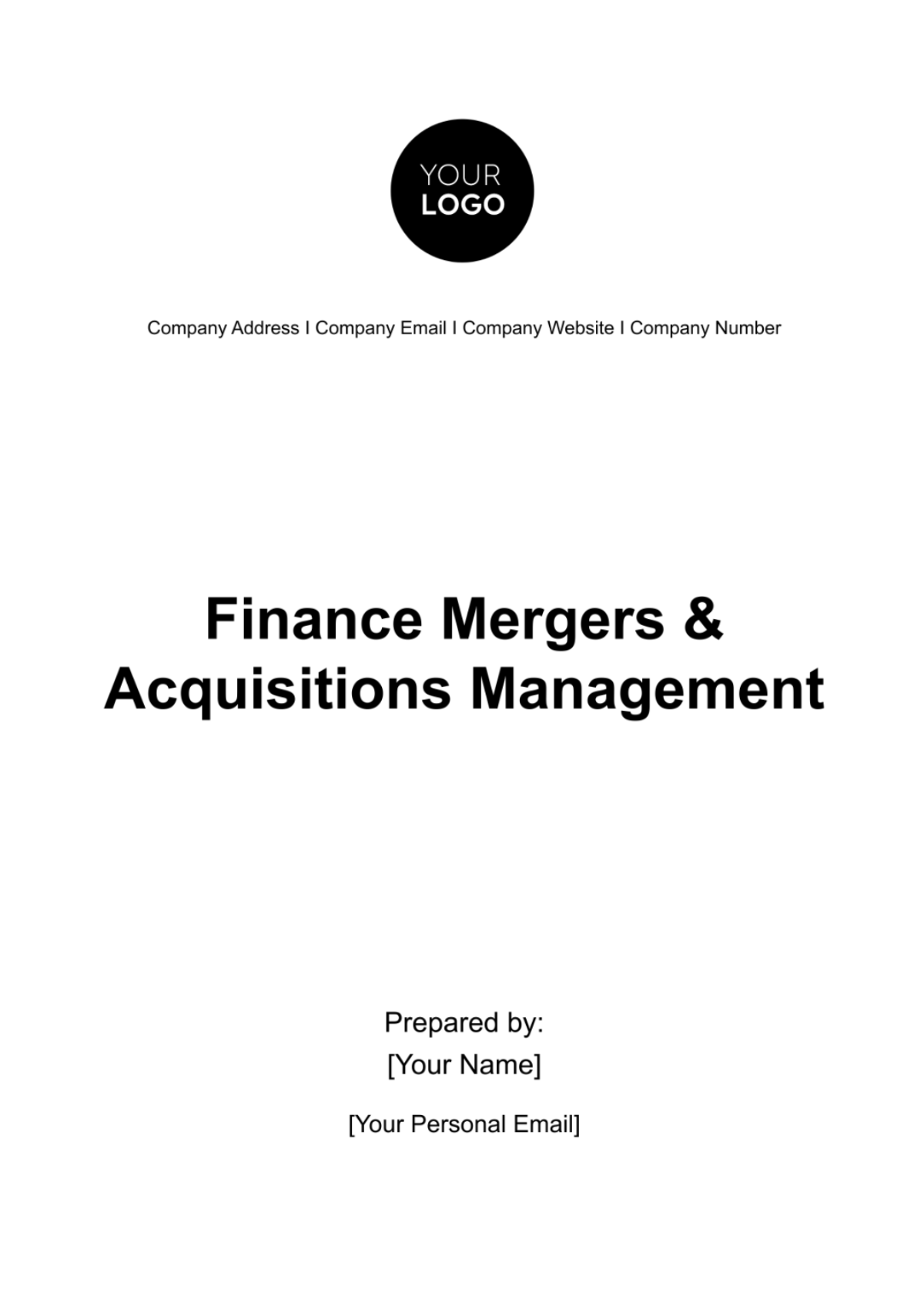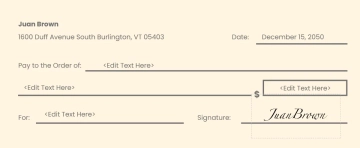Free Finance Mergers & Acquisitions Management

I. Introduction
A. Background
This document serves as a guiding force through the intricate landscape of business transactions. Rooted in the historical evolution of corporate finance practices, M&A has become integral to our organizational growth, restructuring, and enhanced market positioning. We recognize the influences of economic dynamics, technological advancements, and regulatory changes shaping the M&A landscape, underscoring the need for a comprehensive document to empower informed decision-making. The adaptability of this document mirrors our commitment to staying at the forefront of financial strategies and technological innovations, ensuring its enduring relevance in our ever-evolving business environment.
B. Objectives
Strategic Alignment
Articulate strategic objectives that guide each M&A transaction, ensuring alignment with overarching organizational goals for sustained growth.
Financial Optimization
Focus on maximizing value for both acquiring and target entities, employing sound financial strategies, considering factors such as valuation, financing options, and cost synergies.
Risk Mitigation
Comprehensive identification and mitigation of risks, covering financial, operational, legal, and market risks, safeguarding the interests of all stakeholders.
Stakeholder Communication
Prioritize developing a robust communication strategy, keeping stakeholders informed and engaged throughout the M&A process, fostering transparency and trust.
Post-Merger Integration Success
Ensuring the seamless integration of merging entities post-transaction is a priority, focusing on operational, cultural, and technological aspects to realize anticipated synergies and achieve post-merger objectives.
II. Deal Rationale
A. Strategic Objectives
Articulating strategic objectives is the cornerstone of our M&A approach. Each transaction is carefully aligned with overarching organizational goals, be it market expansion, diversification, or gaining a competitive edge. By ensuring synergy between our strategic objectives and M&A activities, we guarantee that every transaction contributes meaningfully to our long-term success.
B. Competitive Landscape Analysis
At the heart of our M&A strategy lies a comprehensive analysis of the competitive landscape. We diligently identify key competitors, analyze market trends, and anticipate potential disruptors. This proactive approach provides us with a contextual backdrop, enabling strategic decisions that not only respond to but also anticipate the ever-evolving dynamics of our industry.
C. Financial Benchmarking
Utilizing financial benchmarking is a fundamental step in our M&A decision-making process. We assess the target company's performance against industry standards, providing invaluable insights into its financial health. This data-driven approach ensures that our valuation considerations are well-informed, contributing to the financial optimization of the entire M&A transaction.
D. Synergy Identification
Identifying and evaluating potential synergies is a pivotal aspect of our M&A strategy. We go beyond mere financial considerations, assessing how the merging entities' resources, capabilities, and market positions can create value greater than the sum of individual parts. This emphasis on synergy ensures that our M&A transactions contribute not only to financial growth but also to operational efficiency and overall organizational enhancement.
E. Risk and Opportunity Assessment
Our M&A strategy is underpinned by a comprehensive risk and opportunity assessment. We proactively identify and mitigate risks, covering financial, operational, legal, and market aspects. Simultaneously, we keenly assess opportunities presented by market volatility, economic shifts, and industry-specific challenges. This dual-focus fosters risk mitigation and value creation, ensuring that our M&A endeavors are not only financially sound but also strategically positioned to capitalize on favorable conditions.
III. Implementation Framework
The table below outlines key components providing a concise overview of the strategic elements that guide our M&A initiatives:
Element | Description | Responsible Party | Timeline |
Due Diligence | Comprehensive examination of target company. | M&A Team | 3 months pre-M&A |
The framework provides a structured approach, ensuring that each stage of the M&A process is well-defined and executed systematically. Due Diligence stands as the initial pillar in our Implementation framework, representing the thorough examination of the target company before any formal agreements take place. This meticulous process involves assessing the target's financial health, operational capabilities, legal standing, and potential risks. The responsible party, the M&A Team, spearheads this stage three months before the formal initiation of the M&A process. As of the latest update, the Due Diligence process is currently in progress.
By breaking down the complex M&A journey into manageable components, the Framework enhances transparency, accountability, and efficiency. It enables all stakeholders to have a clear understanding of their roles, timelines, and progress status, fostering effective collaboration. Moreover, it acts as a strategic guide, aligning the entire organization toward common objectives and ensuring that each M&A transaction is executed with precision, minimizing uncertainties and maximizing the potential for success.
IV. Financial Analysis and Modeling
The table below elucidates the systematic approach we undertake to ensure accurate valuation and informed decision-making:
Element | Description | Responsible Party | Timeline |
Financial Statements | Reviewing the target company's financial statements. | Financial Analysts | 2 months pre-M&A |
This stage is pivotal as it provides a baseline for the valuation process. Through a thorough analysis of financial statements, we can identify trends, assess the historical financial performance, and gain insights into the company's revenue streams and cost structures. The Financial Analysts play a crucial role in interpreting the financial health of the target, facilitating informed decision-making during subsequent stages of the M&A process. This not only informs the negotiation and agreement phases but also lays the groundwork for developing a sound financing strategy.
V. Financing Strategy
A. Capital Structure Analysis
Our ongoing analysis of the current capital structure has yielded insightful results. By optimizing the mix of debt and equity for the M&A transaction, we anticipate enhanced financial flexibility and a more balanced risk profile. The assessment of the cost of capital, including considerations of interest rates, has provided a clear roadmap for structuring our financial approach.
B. Financing Options Exploration
The thorough exploration of various financing options, including traditional bank loans, private equity, and bonds issuance, has culminated in a comprehensive understanding of their respective advantages and disadvantages. This analysis, grounded in our current financial health and market conditions, ensures that our financing strategy is not only aligned with but strategically advances our broader M&A objectives.
C. Risk Mitigation in Financing
The active development of a robust risk mitigation strategy tied to our financing approach has resulted in proactive measures. These include financial hedges and contingency plans that will safeguard against adverse impacts on our financing plan. This comprehensive approach ensures financial stability throughout the M&A process, even in the face of potential challenges like interest rate fluctuations or unforeseen operational issues.
D. Financial Due Diligence for Lenders
Detailed financial statements, cash flow projections, and a meticulous analysis of key financial metrics collectively communicate our growth prospects and risk management strategies, fostering confidence among potential financiers.
VI. Integration Planning
A. Operational Integration Strategy
Our focus on developing a detailed operational integration strategy has resulted in clear roles, responsibilities, and timelines for key personnel involved in the integration process. This meticulous planning ensures a seamless transition, optimizing operational efficiency and minimizing disruptions.
B. Cultural Integration Initiatives
Initiatives addressing cultural integration challenges are actively fostering a positive working environment. Open communication, cultural sensitivity, and team-building activities have already begun bridging gaps between organizational cultures, creating a cohesive and inclusive atmosphere.
C. Technological Alignment
The evaluation of existing systems, infrastructure, and IT processes has identified areas for integration or potential upgrades. The ongoing implementation of a technology roadmap ensures a smooth flow of information and operational continuity, aligning technological aspects seamlessly between the merging entities.
D. Customer and Employee Transition Plans
Comprehensive plans for the transition of both customers and employees are being fine-tuned. Transparent communication, addressing concerns, and implementing support mechanisms are actively underway, ensuring a smooth transition process. Our focus on employee retention and maintaining customer satisfaction remains central to the success of the integration strategy.
E. Performance Measurement Metrics
Regular monitoring of operational efficiency, employee satisfaction, customer retention, and financial performance has been established. This ongoing assessment will guide data-driven adjustments, allowing us to optimize the integration process and ensuring that key performance indicators align with our overarching M&A objectives.
VII. Communication and Stakeholder Management
A. Stakeholder Mapping and Analysis
We've conducted a thorough stakeholder mapping and analysis to identify key individuals and groups affected by the M&A process. This includes internal and external stakeholders, allowing us to tailor communication strategies based on their specific needs and concerns.
B. Communication Plan Development
A comprehensive communication plan has been developed, outlining the cadence, channels, and key messages for various stages of the M&A process. This proactive approach ensures transparent and consistent communication, fostering trust and mitigating uncertainty among stakeholders.
C. Issue Resolution Mechanisms
Robust issue resolution mechanisms have been put in place. This includes a dedicated team responsible for promptly addressing concerns and unforeseen challenges that may arise during the M&A process. Regular updates and feedback loops are integral components of our issue resolution strategy.
VIII. Risk Management and Contingency Planning
A. Risk Identification and Assessment
We've identified and assessed a comprehensive range of risks associated with the M&A transaction, covering financial, operational, legal, and market aspects. This process allows us to proactively mitigate potential challenges and make informed decisions throughout the entire M&A journey.
B. Contingency Planning Strategies
Contingency planning strategies have been developed to address identified risks. This includes predefined action plans, alternative scenarios, and resource allocation strategies to ensure a swift and effective response in the face of unexpected events, safeguarding the overall success of the M&A transaction.
C. Continuous Monitoring and Adjustment
Continuous monitoring of identified risks and the effectiveness of contingency plans is a dynamic part of our approach. Regular assessments and adjustments ensure that our risk management strategies remain adaptive and aligned with the evolving landscape of the M&A environment.
IX. Post-Merger Evaluation
A. Performance Metrics Review
We will conduct a thorough review of the established performance metrics during the integration planning phase. This will encompass a comprehensive assessment of operational efficiency, employee satisfaction, customer retention, and financial performance. Insights gained from this review will guide future decision-making and refine our strategies for subsequent M&A endeavors.
B. Lessons Learned Analysis
An in-depth analysis of lessons learned from the M&A process will be undertaken. This will involve identifying successes, challenges, and areas for improvement. By distilling key insights, we aim to enhance our organizational learning and apply valuable lessons to future M&A initiatives.
C. Continuous Improvement Initiatives
We will proactively implement continuous improvement initiatives based on the lessons learned. This forward-looking approach ensures that our organization evolves and grows from each M&A experience, optimizing processes and strategies for ongoing success in a dynamic business environment.
D. Stakeholder Feedback Incorporation
Soliciting feedback from stakeholders involved in or affected by the M&A process, we will incorporate their insights into our evaluation. This inclusive approach ensures that the perspectives of all parties are considered, fostering a culture of collaboration and responsiveness to stakeholder needs.
E. Impact on Company Culture Assessment
We will assess the impact of the M&A transaction on our company culture. This involves understanding how the integration has influenced values, communication, and collaboration within the organization. Insights gained will inform strategies to nurture a cohesive and positive company culture post-merger.
F. Synergy Realization Measurement
The realization of synergies identified during the M&A planning will be measured. We will evaluate how well the expected synergies have materialized in terms of operational efficiencies, cost savings, and strategic advantages. This assessment guides our approach to identifying and maximizing synergies in future M&A activities.
- 100% Customizable, free editor
- Access 1 Million+ Templates, photo’s & graphics
- Download or share as a template
- Click and replace photos, graphics, text, backgrounds
- Resize, crop, AI write & more
- Access advanced editor
Efficiently manage mergers and acquisitions with the Finance Mergers & Acquisitions Management Template, a comprehensive resource on Template.net! This editable and customizable document guides you through the process seamlessly. Tailor effortlessly with our AI Editor Tool, ensuring smooth transitions, optimized integration, and overall financial success. Enhance your management approach by downloading!





























